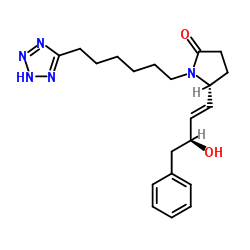| Description |
TCS 2510 is a selective EP4 agonist. TCS 2510 can be used for the research of metabolic diseases[1].
|
| Related Catalog |
|
| Target |
EP4
|
| In Vitro |
TCS 2510 (0.001~100 μM; GLUTag cells) stimulates glucagon like peptide 1 secretion. TCS2510 activates the Gas signaling pathway. TCS 2510 (10 μM; 2~24 h; GLUTag cells) increases the Gcg mRNA expression levels. TCS 2510 produces a concentration dependent increase in cAMP levels in GLUTag cells with EC50 of 20 nM and the maximal stimulation of 60 % over the basal cAMP levels. The decrease in cell impedance in GLUTag cells observed with TCS 2510 is concentration dependent with IC50 of 15 nM. TCS 2510 produces a concentration-dependent increase in glucagon like peptide 2 secretion in GLUTag cells[1].
|
| In Vivo |
TCS 2510 (0.1~10 mg/kg; p.o.) produces a dose-dependent elevation in plasma glucagon like peptide 1 levels in fasted mice measured 15 min after compound administration[1]. TCS 2510 (10 mg/kg; p.o.) increases plasma glucagon like peptide 1 levels up to 8-fold over the basal hormone levels[1]. TCS 2510 (1~10 mg/kg; p.o) affords a significant elevation in plasma glucagon like peptide 2 levels[1] Animal Model: Mice[1] Dosage: 0.1~10 mg/kg Administration: P.o. Result: Produced a dose-dependent elevation in plasma glucagon like peptide 1 levels in fasted mice measured 15 min after compound administration. Animal Model: Mice[1] Dosage: 10 mg/kg Administration: P.o. Result: Increased plasma glucagon like peptide 1 levels up to 8-fold over the basal hormone levels. Animal Model: Mice[1] Dosage: 1~10 mg/kg Administration: P.o. Result: Afforded a significant elevation in plasma glucagon like peptide 2 levels.
|
| References |
[1]. Coskun T, et al. Activation of prostaglandin E receptor 4 triggers secretion of gut hormone peptides GLP-1, GLP-2, and PYY. Endocrinology. 2013;154(1):45-53.
|
